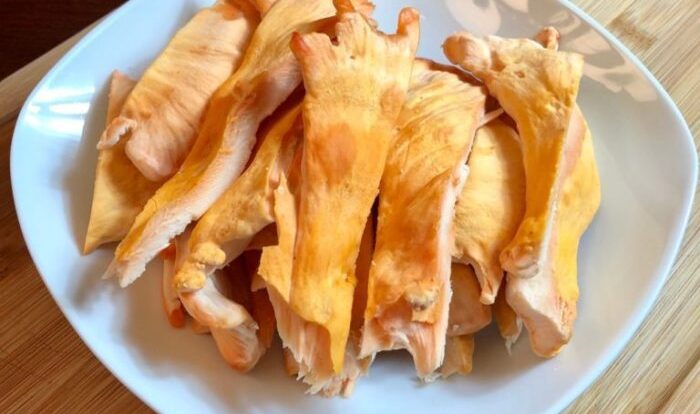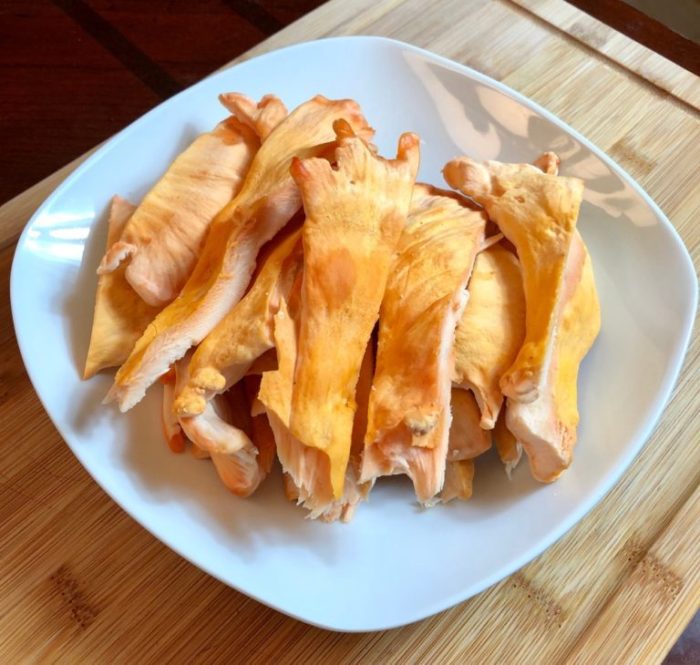
Unleash the flavors of the forest with our tantalizing Chicken of the Woods Recipe. Embark on a culinary adventure as we explore its distinct aromas, delectable taste, and versatile culinary applications. From harvesting and identification to nutritional benefits and cultural significance, this recipe guide is your passport to a world of gastronomic delights.
Culinary Delights
Chicken of the Woods is a unique and flavorful mushroom that offers a delightful culinary experience. Its distinct aromas and flavors make it a favorite among mushroom enthusiasts and chefs alike.
When fresh, Chicken of the Woods exudes a fruity, slightly floral aroma. This aroma intensifies upon cooking, releasing a savory, earthy fragrance that fills the kitchen. The taste of Chicken of the Woods is equally captivating. It has a firm, meaty texture that resembles chicken, with a mild, slightly nutty flavor.
This makes it a versatile ingredient that can be used in a wide variety of dishes.
Comparison to Other Edible Mushrooms
Compared to other edible mushrooms, Chicken of the Woods has a milder flavor profile. It lacks the strong umami taste of shiitake or the earthy flavor of oyster mushrooms. Instead, it offers a subtle, delicate flavor that complements other ingredients without overpowering them.
For a delectable vegetarian meal, try this chicken of the woods recipe . This unique mushroom has a meaty texture and savory flavor that mimics chicken, making it a great substitute in many dishes. Whether you’re a seasoned vegetarian or simply looking for a healthy and delicious meal, this recipe is sure to impress.
Creative Culinary Ideas
The unique characteristics of Chicken of the Woods make it a versatile ingredient that can be used in various culinary creations. Here are a few ideas to inspire your next meal:
- Pan-fried Chicken of the Woods: Slice the mushrooms into thin strips and pan-fry them with butter and garlic until golden brown. Serve as a side dish or as a topping for pasta or salads.
- Grilled Chicken of the Woods: Brush the mushrooms with olive oil and grill them until tender. Serve with a squeeze of lemon and a sprinkle of fresh herbs.
- Chicken of the Woods Soup: Sauté the mushrooms with onions and celery, then simmer in a flavorful broth. Add vegetables, rice, or pasta for a hearty and comforting soup.
- Chicken of the Woods Risotto: Toast arborio rice in butter, then gradually add chicken stock and cook until creamy. Stir in sautéed Chicken of the Woods and Parmesan cheese for a rich and flavorful risotto.
Harvesting and Identification: Chicken Of The Woods Recipe

Chicken of the Woods, a delectable edible fungus, offers a unique culinary experience. To ensure a successful harvest, it’s crucial to understand the optimal time and techniques. Additionally, proper identification is essential to distinguish it from lookalikes and promote responsible foraging practices.
Harvesting
The prime time to harvest Chicken of the Woods is during the late summer and early fall. Search for healthy specimens with firm, young fronds. To harvest, gently twist or cut the mushroom at its base, leaving the root intact to allow for future growth.
Identification
Chicken of the Woods boasts distinctive features that set it apart from its counterparts. It typically forms bright orange or yellow clusters on fallen logs or dead trees. Its unique shape resembles chicken combs or ruffled feathers, giving it its name.
However, it’s essential to note that some lookalikes, such as the toxic Jack-o’-Lantern mushroom, may share similar colors. To ensure accurate identification, consult field guides or seek guidance from experienced foragers.
Responsible Foraging, Chicken of the woods recipe
Responsible foraging is vital to preserve the delicate balance of forest ecosystems. Always harvest sustainably, leaving plenty behind for other foragers and wildlife. Avoid damaging the environment by staying on designated trails and respecting the rights of landowners. Additionally, educate yourself about the species you’re harvesting to prevent over-collection or the gathering of endangered varieties.
If you’re looking for a hearty and flavorful vegetarian dish, consider trying this chicken of the woods recipe . This edible mushroom has a meaty texture and a slightly spicy flavor, making it a perfect substitute for chicken in many recipes.
Whether you’re making a stir-fry, a soup, or a hearty stew, this recipe will add a delicious and nutritious element to your meal.
Culinary Applications

Chicken of the Woods’ culinary versatility extends far beyond its resemblance to poultry. Its firm texture and meaty flavor make it an excellent substitute for chicken or other meats in various cuisines. Let’s explore its endless possibilities in the culinary realm.
Culinary Versatility
- Stir-fries and Sautéing:Its meaty texture makes it an ideal addition to stir-fries, sautéed dishes, and curries. Its ability to absorb flavors makes it a flavorful complement to a wide range of sauces and seasonings.
- Soups and Stews:Chicken of the Woods adds a hearty texture and umami depth to soups and stews. Its meaty flavor stands out even when cooked in long-simmering dishes, making it a great addition to hearty meals.
- Roasting and Grilling:When roasted or grilled, Chicken of the Woods develops a slightly crispy exterior while maintaining a tender interior. Marinating or seasoning it with herbs and spices before cooking enhances its flavor profile.
- Tacos and Burritos:Its shredded texture and savory flavor make it an excellent filling for tacos and burritos. Its meaty texture provides a satisfying bite, while its ability to absorb flavors makes it a versatile ingredient for various fillings.
- Salads and Sandwiches:Thinly sliced or shredded Chicken of the Woods adds a unique texture and umami flavor to salads and sandwiches. Its meaty flavor complements a variety of greens, vegetables, and dressings.
Preservation and Storage
Proper preservation and storage are crucial to maintain the freshness and flavor of Chicken of the Woods. Here are some tips:
- Refrigeration:Fresh Chicken of the Woods can be stored in the refrigerator for up to 5 days. Wrap it in a damp paper towel and place it in an airtight container to maintain moisture.
- Freezing:For longer storage, freezing Chicken of the Woods is an excellent option. Cut it into bite-sized pieces, blanch it in boiling water for 2-3 minutes, and then freeze it in airtight containers for up to 6 months.
- Drying:Drying Chicken of the Woods is a great way to preserve its flavor and extend its shelf life. Cut it into thin strips, spread it on a baking sheet, and dry it in a low-temperature oven (150-175°F) for several hours or until completely dry.
Health and Nutritional Benefits

Chicken of the woods is not only a delectable delicacy but also a nutritional powerhouse. It boasts an impressive array of vitamins, minerals, and antioxidants, making it a valuable addition to a healthy diet.
Research suggests that Chicken of the woods is rich in fiber, protein, and essential vitamins like vitamin D, vitamin C, and B vitamins. It also contains a significant amount of minerals such as potassium, phosphorus, and iron.
Antioxidant Activity
Chicken of the woods has been found to possess potent antioxidant properties. Antioxidants help protect cells from damage caused by free radicals, which are unstable molecules that can contribute to chronic diseases like cancer and heart disease. Studies have shown that Chicken of the woods extract has strong antioxidant activity, comparable to or even exceeding that of other popular edible mushrooms like shiitake and oyster mushrooms.
Immune-Boosting Effects
Chicken of the woods is believed to have immune-boosting properties. It contains polysaccharides, which are complex carbohydrates that have been shown to stimulate the immune system. Some research suggests that Chicken of the woods extract may enhance the production of immune cells, such as natural killer cells, which play a crucial role in fighting infections and tumors.
Anti-Inflammatory Properties
Chicken of the woods has also been studied for its potential anti-inflammatory effects. Inflammation is a natural response to injury or infection, but chronic inflammation can contribute to various health problems. Research indicates that Chicken of the woods extract may possess anti-inflammatory properties, which could be beneficial for conditions like arthritis, inflammatory bowel disease, and other inflammatory disorders.
Nutritional Comparison
Compared to other edible mushrooms, Chicken of the woods stands out with its unique nutritional profile. It has a higher protein content than many other mushrooms and is a good source of essential amino acids. Chicken of the woods also contains a higher concentration of vitamin D and potassium compared to common mushrooms like white button mushrooms or cremini mushrooms.
| Nutrient | Chicken of the Woods | Shiitake Mushrooms | Oyster Mushrooms |
|---|---|---|---|
| Protein | 2-3% | 2-3% | 1-2% |
| Vitamin D | 2-5 IU/100g | 0-2 IU/100g | 0-1 IU/100g |
| Potassium | 300-500 mg/100g | 200-300 mg/100g | 150-250 mg/100g |
Cultural Significance and Culinary Traditions
Chicken of the Woods holds cultural and culinary significance in various regions worldwide, deeply intertwined with local traditions and folklore.
Ancient Origins and Medicinal Use
Chicken of the Woods has been used for centuries in traditional medicine, particularly in China and Japan. In ancient Chinese texts, it was believed to possess healing properties and was used to treat ailments such as digestive issues and respiratory problems.
Culinary Delicacy in Europe
In Europe, Chicken of the Woods has been a prized culinary ingredient for centuries. It is particularly popular in Eastern Europe, where it is often used in soups, stews, and sauces. In Ukraine, it is known as “Lysychka” and is considered a delicacy.
Folklore and Symbolism
Chicken of the Woods has also played a role in folklore and mythology. In some cultures, it is believed to bring good luck and prosperity. In others, it is associated with the supernatural and is said to be able to ward off evil spirits.
End of Discussion
As you savor the last bite of your Chicken of the Woods dish, let the flavors linger and the memories of this culinary journey inspire your future culinary creations. Whether you’re a seasoned chef or a home cook seeking adventure, the Chicken of the Woods Recipe empowers you to transform the bounty of nature into unforgettable meals.
Commonly Asked Questions
What is the best way to harvest Chicken of the Woods?
Harvest Chicken of the Woods when it’s young and tender, typically in the summer and fall. Cut the mushrooms close to the base, leaving the root intact to ensure future growth.
How can I identify Chicken of the Woods?
Chicken of the Woods has bright orange to yellow shelf-like structures with a velvety texture. Its underside is white to cream-colored and has small pores. Avoid mushrooms with slimy or foul-smelling flesh.
What are the nutritional benefits of Chicken of the Woods?
Chicken of the Woods is a good source of dietary fiber, protein, and antioxidants. It also contains vitamins and minerals such as potassium, phosphorus, and niacin.





